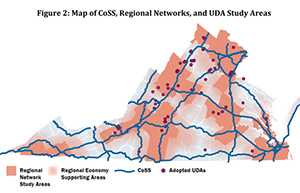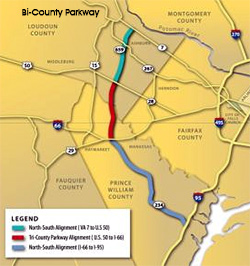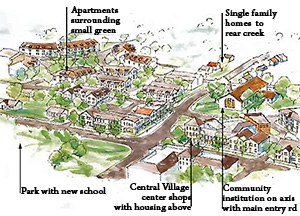Urban Development Areas (UDAs)
County officials appear to think private developers should be able to build anything, anywhere - and get the Virginia Department of Transportation (VDOT) to build a "free" road for any project. Will Prince William County be able to game the system for getting highway funding by trying to claim that most of the County qualifies as an UDA planned for Traditional Neighborhood Development?
 In early September, the Board of County Supervisors will vote to establish Urban Development Areas (UDAs), part of the state's needs assessment used to prioritize transportation funding. The deadline to submit projects for state funding is September 30. In early September, the Board of County Supervisors will vote to establish Urban Development Areas (UDAs), part of the state's needs assessment used to prioritize transportation funding. The deadline to submit projects for state funding is September 30.
The Virginia Statewide Transportation Needs Assessment, required by House Bill 2, is the scoring process now being used to prioritize transportation improvements.
In order to be funded, proposed road projects must meet a need identified as (1) a Corridor of Statewide Significance, (2) a Regional Network, and/or (3) an Urban Development Area, and/or (4) a Statewide Safety Need.
This opportunity to attract transportation improvements to core growth areas could spur mixed-use development and help attract economic investments. However, Prince William planning officials just don't get it. The County is trying to slap the UDA designation on almost every planning category in the county... still trying to use public transportation funds to subsidize sprawl.
In early September, the Board of County Supervisors will vote to establish Urban Development Areas. The deadline to submit projects for state funding is September 30.
This opportunity to attract transportation improvements to core growth areas could spur mixed-use development and help attract economic investments. However, Prince William planning officials just don't get it. The County is trying to slap the UDA designation on almost every planning category in the county... still trying to use public transportation funds to subsidize sprawl.
County officials appear to think private developers should be able to build anything, anywhere - and get the Virginia Department of Transportation (VDOT) to build a "free" road for any project.
The Virginia General Assembly took steps to end the "free roads for developers, anywhere" game in the last two years. In 2013 legislators increased taxes substantially to fund transportation projects.
 Then came the debacle when VDOT could not explain why it proposed to fund the Bi-County Parkway. Then came the debacle when VDOT could not explain why it proposed to fund the Bi-County Parkway.
The new taxes were supposed to be spent to solve problems, such as congestion on I-66. But the Republican-controlled legislature had not taken a great deal of political heat and raised taxes just to fund pet projects for a few well-connected developers.
The 2014 legislature mandated in House Bill 2 (HB2) that VDOT must create a new process to rank transportation projects based on clear criteria. In the HB2 process, one of those criteria is whether the project would facilitate growth in an Urban Development Area (UDA).
Steering new housing to UDAs is expected to facilitate carpooling and transit, and spur Traditional Neighborhood Development where jobs are located near new housing. Creating live-work-play communities is expected to reduce commuting requirements and, over time, minimize the demand for more highways.
The General Assembly recognized in the last two years that transportation solutions can come from tackling demand (the need for new roads) as well as supply (construction of new roads). UDA's could minimize the need for politicians to raise taxes again in another 20 years.
Many local jurisdictions are designating just a few spots as UDAs. Fairfax County designated just Tysons, initially. Identifying just a few locations as UDA's will help state officials complete transportation initiatives that will be more effective in reducing congestion, increasing safety, and stimulating economic development.
In contrast, in the old process for funding projects in the Six Year Implementation Plan, political pressures resulted in a scattershot approach with fragmented investments.
The county could choose a few locations, such as areas already designated for Urban Mixed Use and Mass Transit Node, and focus on creating Traditional Neighborhood Development there. Instead, PWC officials are making the outrageous claim that most of the county qualifies as an Urban Development Area. Even places planned for Industrial Employment (EI) and General Commercial (GC) qualify.
State officials will review whatever the county submits by the September 30, 2015 deadline. If they determine Prince William's claims are not credible, the county could end up watching the Commonwealth Transportation Board direct 2016 funding to projects where jurisdictions made legitimate UDA designations.
Will Prince William County be able to "game" the system for getting highway funding, by trying to claim most of the county qualifies as an Urban Development Area (UDA) planned for Traditional Neighborhood Development?
The Office of Intermodal Planning and Investment (OIPI) of the Secretary of Transportation is supposed to review claims of local jurisdictions, when they submit the boundaries of their UDA's.
 That state agency says Traditional Neighborhood Development embodies classic characteristics of traditional communities such as: That state agency says Traditional Neighborhood Development embodies classic characteristics of traditional communities such as:
- Walkable neighborhood centers
- Interconnected streets and blocks
- Diversity of land uses
- Easy access to jobs, housing and recreation by a variety of travel options (auto, bus, walk, bike, etc.)
The Transportation Efficient Land Use and Design Guide provides examples of these principles in real places in Virginia and lists tangible economic and quality of life benefits resulting from these design approaches.
Prince William has an opportunity to focus transportation funding to implement its vision to create live-work-play communities. Instead, the county is shooting for the moon, hoping the state will ignore its own requirements to steer transportation funding in the HB2 ranking process to support development that minimizes the need for new highways.
If you want to fund any transportation, anywhere, to support further sprawl, guaranteeing higher taxes in the future, then Prince William is the county trying to do that. How did we get this far with no public discussion? |